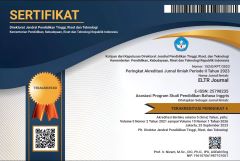TEXT-TYPE-BOARD AS A LEARNING MEDIA TO INCREASE JUNIOR HIGH SCHOOL STUDENTS’ INDEPENDENT LEARNING
Abstrak terlihat: 273 / PDF terunduh: 302DOI:
https://doi.org/10.37147/eltr.v3i2.42Keywords:
learning media, text types board, junior high school students, text types in EnglishAbstract
This study was intended to see whether a set of text type board for junior high school students can help them to find some basic information about text types in English in a simple way. This learning media also help the students find proper sources of information directly. This study was conducted to answer on a question about how the text type board teaching media affect the junior high school students’ learning process. The writer concern about their independent learning on student’s learning process. The data were gathered from questionnaire and interview. All of the data from Research and Information with interview technique was going to be analyzed. The interview was conducted for two of English teacher in SMP Putra Tama and all of the 7th and 8th grades of SMP Putra Tama. The writer presented the learning media called Text-Types-Board. Then, the writer applied it to7th and 8th grades of SMP Putra Tama for four times. The research was conducted on March 29th, 30th2017 and 5th, 6th April 2017. The students said that the availability of the Text Types Board really helps them solve the problem about English texts by themselves.
Downloads
References
Aini, W. N. (2013). Instructional media in teaching English to young learners: A case study in elementary schools in Kuningan. Unpublished thesis, Universitas Pendidikan Indonesia.
Bandura, A. (1991). Social cognitive theory of self-regulation. Organizational Behavior and Human Decision Processess, 50, 248-287.
Bertram, C., Ranby, P., Adendorff, M., Reed, Y., & Roberts, N. (2010). Using media in teaching. Cape Town: South African Institute for Distance Education.
Borg, W.R. & Gall, M. D. (1983). Educational research: An introduction (4th Ed). New York: Longman.
Creswell, J. W. (2012). Educational research: Planning, conducting, and evaluating quantitative and qualitative research (4th Ed). Boston: Pearson Education, Inc.
Dick, W., Carey, L., & Carey, J. (2009). The systematic design of instruction. Upper Saddle River, NJ: Pearson Education Limited.
Harmer, J. (2007). The practice of language teaching. Cambridge: Ashford Color Press.
Kemp, J. (2001). Instructional design: A plan or unit and course development. New York: Wiley Inc.
Kotler, P. (1995). Marketing management analysis, planning, implementation & control. Cambrige: Prentice Hall Int.
Nevid, J. (2013). Psychology: Concepts and applications. Belmont: Wadworth.
Nunan, D. (1979). Practical English language teaching. New York: McGraw-Hill Publisher.
Reiser, R. A. & Dick, W. (1996). Instructional planning (2nd Ed). Boston: Allyn and Bacon.
Rotter, W and Bendl, H. (1978). Your companion to English texts: Comprehension - analysis – appreciation – production (Kollegstufe/Abitur/Universität). München: Manz.
Sands, L. B. (1965). Audio-visual procedures in teaching. New York: University of California.
Slavin, R. E. (2012). Educational psychology: Theory and practice (10th Ed). Pearson: Johns Hopkins University.
Van Els, T., Bongaerts, T., Extra, G., Van Os, Charles., Dieten, A. M. J. (1984). Applied linguistics and the learning and teaching of foreign languages. London: Munshiram Manoharlal Publishers Pvt. Ltd.
Verner, S. (2009). How to teach writing: 6 methods for generating writing ideas. Retrieved on September 25th , 2016, from http://busyteacher.org/4650-how-to-teach-writing-6-methods-for-generating.html
Wilson, L. M. &Horch, H. W. (2002). Implications of brain research for teaching young adolescents (3rd Ed). New York: Middle School Journal.
Downloads
Published
How to Cite
Issue
Section
License
Copyright (c) 2019 victory cahya adi

This work is licensed under a Creative Commons Attribution-ShareAlike 4.0 International License.













